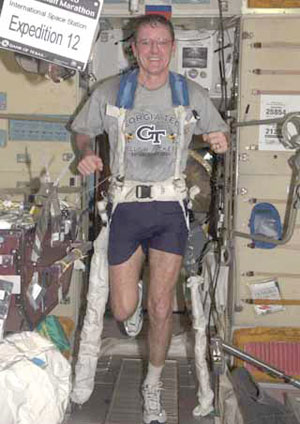 Unfortunately most people don’t look for running injury solutions before they get injured. Of course there is a minority of people out there who are looking for any excuse not to exercise, but for most people running is a way of life. Not everyone out these is built to run and many people spend most of their time sitting behind a desk at work. These and other factors can contribute to developing a running injury when you least expect it.
Unfortunately most people don’t look for running injury solutions before they get injured. Of course there is a minority of people out there who are looking for any excuse not to exercise, but for most people running is a way of life. Not everyone out these is built to run and many people spend most of their time sitting behind a desk at work. These and other factors can contribute to developing a running injury when you least expect it.
How Space Travel Research Can Help Prevent Your Next Running Injury
If you’re sitting at a desk for 50 hours a week and try to run three times a week lose weight, you’re probably asking for a running injury. You body is not conditioned to withstand those types of forces. Recent research studies comparing the effects of bed rest and gravity deprived environments are similar to the effects of sitting with poor posture all day. Think about it. Are your muscles working to hold you up or is the chair supporting you? It’s unfortunate, but your body doesn’t see bed rest much differently than slumping in your chair at work or in front of the T.V.
Studies show that single joint muscles tend to weaken most quickly. These are the postural muscles that are supposed to work for us continuously. This is bad news for core stability. These muscles also forget how to work continuously, firing on and off only when called upon. They no longer function as the dynamic corset designed to protect the spine from injury. Also, a weak core can contribute to other overuse running injuries such as knee, hip and foot injuries.
But that’s not all. After bed rest or prolonged exposure to gravity free environments, multi-joint muscles become tighter and more active. This leads to muscle imbalance. Examples of this type of muscle are the hamstrings and the gastrocs.
The Solution
You want to load the spine in a safe and controlled manner to retrain the muscles to respond to the effects of gravity appropriately. One way to do this is to stretch tall through the crown of your head, with your chin tucked in gently. At the same time, bring the shoulder blades down and back together. This will help the abdominal corset contract. The key to success is to focus on specifically contracting the deep core muscles. You want to start out with low loads and breath normally, challenging yourself with different positions, and eventually training in sport specific activities.
These principles are bases on research studies, and are not intended to use for a specific running injury. Before taking on any new exercise program you should consult your health care provider. If you have questions, call to schedule a free consult.
